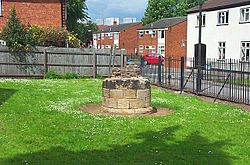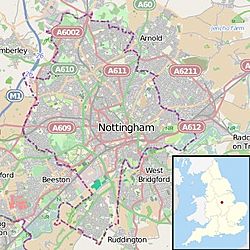Lenton Priory facts for kids

The remains of a stone column from the priory
|
|
| Monastery information | |
|---|---|
| Order | Cluniac |
| Established | C.1102-8 |
| Disestablished | 1538 |
| Mother house | Cluny Abbey |
| Dedicated to | Holy Trinity |
| People | |
| Founder(s) | William Peverel |
| Site | |
| Location | Lenton, Nottingham, Nottinghamshire |
| Coordinates | 52°56′37″N 1°10′43″W / 52.943611°N 1.178611°W |
| Grid reference | SK5518938819 |
Lenton Priory was a special kind of monastery called a Cluniac house. It was located in Nottinghamshire, England. A powerful man named William Peverel started it around 1102-1108.
The priory received many gifts of land and property from its founder. These gifts later caused big arguments with other groups. Most of the monks at Lenton were from France. This changed in the late 1300s when the priory became independent from its French parent monastery. From the 1200s, the priory often struggled with money. It was known for being "poor and in debt." Lenton Priory was eventually closed down in 1538. This happened during King Henry VIII's time, as part of the Dissolution of the Monasteries.
Contents
History of Lenton Priory
How the Priory Started
William Peverel founded Lenton Priory between 1102 and 1108. It was built in the area of Lenton, Nottingham, near the town of Nottingham. The priory was dedicated to the Holy Trinity.
Peverel said he founded it to honor God. He also wanted to do good for the souls of King William, his wife Queen Matilda, and their son King William.
Lenton Priory was an "alien establishment." This meant it was connected to a main monastery in another country. Lenton's parent monastery was Cluny Abbey in France. Usually, a priory would send some of its money to its parent house. However, Peverel made sure Lenton Priory did not have to do this. They only had to pay a small amount each year as a sign of respect.
William Peverel gave Lenton Priory many valuable gifts. These included towns like Lenton and Radford. He also gave them control of important churches in Nottingham. The priory also received money from fishing and lead mining. They even got money from his horse farms in the Peak District.
Even though these gifts were given, the document that lists them might not be real. Historians believe the founding document was created later.
In the 1200s, Philip Marc, who was the Sheriff of Nottingham, also gave a gift to the priory. He asked the monks to pray for him.
Kings like King Henry I and King John later confirmed these gifts. They also added new ones. For example, the priory received churches in Leicestershire and Derbyshire.
King Henry II gave the priory freedom from taxes and tolls. He also allowed them to hold an eight-day fair. King Henry III later made this fair even longer, lasting twelve days. In 1199, King John let the monks collect wood from the forest of Bestwood. Later, he also allowed them to hunt certain animals in the royal forests.
Disputes Over Property
Lenton Priory faced big problems with Peverel's gifts. This happened after King Henry II took over the Peverel family's lands. King Henry gave these lands to his son, John. When John became King John, he gave the property to the Bishop of Coventry and Lichfield. This started a long argument between the Priory and Lichfield Cathedral. The dispute lasted for about 300 years. They even took their arguments to the Vatican Court.
The disagreement sometimes turned violent. In 1250-1251, Lenton Priory monks tried to steal wool and lambs. These belonged to a church in Tideswell, which Lichfield controlled. The Dean of Lichfield had put the sheep inside the church for safety. But the Lenton monks broke in. A fight started, and 18 lambs were killed inside the church. The monks managed to take 14 lambs.
In another attack, the monks used force to steal geese, hay, and oats. Because of these actions, the Bishop of Lichfield asked the Pope for help. Pope Innocent IV set up a special meeting in 1252. The meeting decided that Lenton Priory had to pay a large fine. They also had to pay back money for the damage they caused. The meeting tried to stop future fights by giving the priory some income from the disputed lands. However, the arguments started again in 1275 and continued until the priory was closed.
Life in the 13th and 14th Centuries
In 1228, the priory church tower collapsed. The next year, King Henry III gave the monks permission to get stone from the Royal Forest. This was to help them rebuild the tower. King Henry III gave other gifts too. He provided oak wood for the monks' dormitory roof. He also gave wood to build the priory church. In 1249, he allowed them to quarry more stone from Sherwood Forest.
Most of the monks at Lenton came from France. They were not used to the cold English winters. In 1257-1258, Pope Alexander IV gave them special permission. They could wear caps during church services because of the "vehement cold."
By 1262, the priory was deeply in debt. An inspection showed that the priory had twenty-two monks. It also owed about £1,000. This was a huge amount, about three times their yearly income. Tax records from 1291 show their income was only about £339 a year.
Because Lenton Priory was connected to a French monastery, its money was sometimes taken by the King. This happened during wars with France in the 1300s. But in 1392, the priory became independent from its French parent house.
Lenton Priory was known for having very nice guest rooms. Several kings visited, including Henry III in 1230. Edward I visited in 1302 and 1303. Edward II came in 1307 and 1323. Edward III visited in 1336.
The priory's money problems continued into the 1300s. By 1313, it was still known for its "poverty and indebtedness." King Edward II put the priory under his protection. He appointed someone to manage its money.
Lenton Priory used to control the Chapel of Saint James in Nottingham. But in 1316, King Edward II took the chapel from Lenton. He gave it to the Nottingham Whitefriars, a group he liked very much.
The Priory's Closure
In 1534, records showed the priory had a yearly income of about £387. But it also had many expenses.
Nicholas Heath was the last prior of Lenton. He became prior in 1535. He had connections to Thomas Cromwell, a powerful figure in King Henry VIII's government. Many letters from Prior Heath to Cromwell still exist.
In February 1538, Prior Heath and many monks were arrested. They were accused of serious wrongdoing against the King. In March, the prior, eight monks, and four laborers from Lenton were punished. Cromwell's private notes show that the prior's fate was decided even before his trial.
The priory was officially closed in 1538. Since the prior and some monks had faced severe consequences, none of the remaining monks received a pension. This was unusual. Even the priory's servants did not get pensions. Five poor people who lived at the priory were left with nothing.
The Lenton Fair
King Henry II gave the priory permission to hold an eight-day fair. It started on November 11th. In 1232, King Henry III made the fair longer, lasting twelve days.
The fair brought in a lot of money for the priory. In 1387, it made £35 out of the priory's £300 yearly income.
The fair often caused arguments with the mayor and people of Nottingham. Around 1300, the town and priory made an agreement. No markets could be held in Nottingham during the Lenton fair. In return, people from Nottingham got special prices to rent booths at the Lenton fair. They also did not have to pay tolls to Lenton Priory during the fair. Each booth was about 8 feet by 8 feet.
| Trade | Booth Hire Price |
|---|---|
| Apothecaries, Cloth merchants, Mercers, Pilchers (makers of fur garments) | 12d. |
| Those selling blacks (Blakkes) and ordinary cloths | 8d. |
| Those selling iron (with extra ground available to hire for 2d.) | 4d. |
The fair continued even after the priory closed. But its length slowly became shorter. Over time, it became known as a horse fair. In the 1800s, farmers and horse dealers often visited it. The fair finally stopped in the early 1900s.
What Happened After the Priory Closed?

The land where the monastery stood changed hands many times after it closed.
William Stretton bought the area in 1802. He built a large house there called "The Priory." William was interested in old things. He removed old stone and parts of buildings while his house was being built. When William died, his son Sempronius inherited the house. Colonel Sempronius Stretton died in 1842. He left the house to his brother, Severus. Neither son really lived there. Severus sold the house.
The Sisters of Nazareth bought the property in 1880. They sold it in the early 2000s. The site was then used to build new homes.
In 2020, archaeologists dug at Lenton Priory for a TV show called The Great British Dig. This show was on More4 in 2021. They found a medieval wall that no one knew about before. It was at the east end of the priory. Experts think it was a previously unknown Lady Chapel. This chapel would have been added to the original Norman building.
What Remains of Lenton Priory Today?
- The Priory Church of St. Anthony, Lenton might include parts of the old monastic hospital chapel.
- The lower parts of a large stone column can still be seen. It is where Old Church Street meets Priory Street.
- A 12th-century font is still used in Holy Trinity Church, Lenton.
- Some old floor tiles are in Nottingham Castle Museum.
- Stained glass from the priory is now in Nuthall Church.


